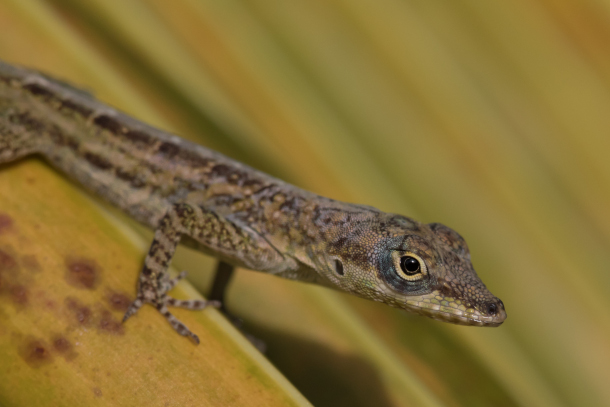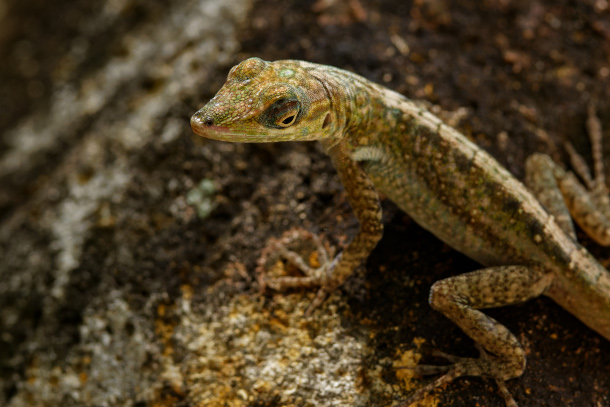Note on Emerging Science: How Lizards Can Breathe Underwater
Air Date: Week of May 26, 2023

Anoles can pull off impressive feats of underwater breathing. The secret, researchers found, is the lizard’s ability to “rebreathe” using a bubble that forms around its snout. (Photo: Adrien Chateignier, Flickr, CC BY-NC-ND 2.0)
Some anole lizards can stay underwater for up to 20 minutes to evade predators, and now researchers have discovered their secret. Living on Earth’s Don Lyman reports that these lizards use a bubble of air around their snouts and rebreathe the bubble in and out.
Transcript
CURWOOD: In a moment, zombie worms and other unusual life forms that emerge when a whale dies, but first this note on emerging science from Don Lyman.
[SCIENCE NOTE THEME]
LYMAN: Anoles – small tropical lizards found mainly in Central and South America, and the Caribbean – will sometimes dive underwater when threatened. Some anoles can stay underwater for up to 20 minutes, but until recently it wasn’t known how they managed to stay submerged for so long. In an effort to find out, Chris Boccia, a doctoral student at Queen’s University in Kingston, Canada, and his colleagues, traveled to Costa Rica where they captured 300 anoles of various species. Some of the experimental anoles were found near streams, while others were found away from streams. Boccia and his fellow researchers then dunked each lizard into containers of river water. While they were underwater, all of the anoles had a bubble of air around their snouts, and they appeared to breathe the bubble in and out. The lizards that were found near streams rebreathed the bubble more often and stayed submerged longer than their land-based relatives, Boccia and his colleagues reported in the Journal of Current Biology. Boccia said that one lizard was underwater for 18 minutes.

Scientists are still figuring out how anoles can rely on their snout bubbles for so long without running out of oxygen. (Photo: Adrien Chateignier, Flickr, CC BY-NC-ND 2.0)
By inserting a small oxygen sensor into the bubbles around the submerged lizards’ snouts, the researchers confirmed that the oxygen levels in the bubbles slowly decreased as the lizards breathed. Boccia suspects the anoles may be able to stay submerged for several minutes by slowing down their metabolism, thus reducing the need for oxygen. He also speculates that as oxygen levels in the snout bubble drop and carbon dioxide levels rise, the bubble may obtain more oxygen by releasing CO2 and taking up dissolved oxygen from the water, but more research is needed to confirm that hypothesis. That’s this week’s note on emerging science. I’m Don Lyman.
Links
Living on Earth wants to hear from you!
Living on Earth
62 Calef Highway, Suite 212
Lee, NH 03861
Telephone: 617-287-4121
E-mail: comments@loe.org
Newsletter [Click here]
Donate to Living on Earth!
Living on Earth is an independent media program and relies entirely on contributions from listeners and institutions supporting public service. Please donate now to preserve an independent environmental voice.
NewsletterLiving on Earth offers a weekly delivery of the show's rundown to your mailbox. Sign up for our newsletter today!
 Sailors For The Sea: Be the change you want to sea.
Sailors For The Sea: Be the change you want to sea.
 The Grantham Foundation for the Protection of the Environment: Committed to protecting and improving the health of the global environment.
The Grantham Foundation for the Protection of the Environment: Committed to protecting and improving the health of the global environment.
 Contribute to Living on Earth and receive, as our gift to you, an archival print of one of Mark Seth Lender's extraordinary wildlife photographs. Follow the link to see Mark's current collection of photographs.
Contribute to Living on Earth and receive, as our gift to you, an archival print of one of Mark Seth Lender's extraordinary wildlife photographs. Follow the link to see Mark's current collection of photographs.
 Buy a signed copy of Mark Seth Lender's book Smeagull the Seagull & support Living on Earth
Buy a signed copy of Mark Seth Lender's book Smeagull the Seagull & support Living on Earth

